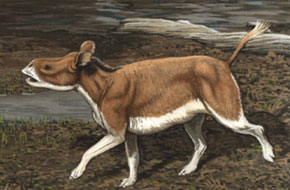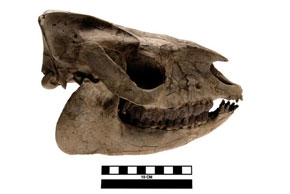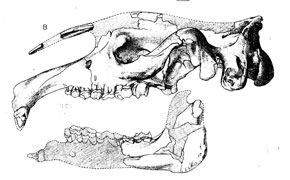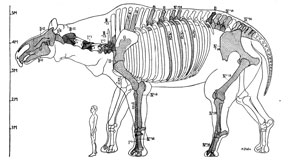Hyracodontidae
 Pictured left: Reconstruction of the Eocene hyracodont rhino Hyracodon, Carl Buell.
Pictured left: Reconstruction of the Eocene hyracodont rhino Hyracodon, Carl Buell.
Hyracodontidae: Hyracodonts were perhaps the most unusual of the rhinos in that they had long slender limbs and feet. In this sense they were more horse-like in body proportions than other rhinos although, unlike horses, hyracodonts retained three toes on all four feet. Hyracodontids showed extreme variation in size, ranging from small, pony-sized species to some of the largest land mammals that ever lived.
The group gets its name from Hyracodon, a roughly pony-size animal from the middle Eocene of North America. Hyracodontids lived in both North America and Asia, but were perhaps more successful in Asia. During the Oligocene and Early Miocene, Indricotherium, the largest land mammal ever, roamed central Asia. Indricotherium was capable of browsing from treetops at heights similar to what modern giraffes are capable of. Unlike a giraffe, however, Indricotherium reached these heights, not by having a greatly elongated neck and legs, but simply due to its immense size.
Early estimates of the size of Indricotherium suggest that it weighed 20-30 tons, which is much larger than any other land mammal to have ever lived and as heavy as some of the largest dinosaurs! More recent estimates are more modest and suggest that Indricotherium was closer to 11 tons, which is similar in size to the largest ice age mammoths. Eleven tons is still very impressive, and much heavier than any living land mammal – the largest African elephants known weigh around 7.5 tons - but perhaps not the extreme giant that earlier estimates claimed. Indricotheres were the last of the hyracodontids and became extinct in the early Miocene.
The AMNH’s Central Asiatic Expeditions of the 1920s discovered a number of specimens of Indricotherium (which was originally known as Baluchitherium). These were described in a series of scientific papers published by the Museum. You can download copies of these papers by clicking on the links below.
Baluchitherium grangeri, a giant hornless rhinoceros from Mongolia.
American Museum novitates; no.78 (1.9MB pdf).
Serridentinus and Baluchitherium, Loh Formation, Mongolia.
American Museum novitates; no. 148 (520KB pdf).
A revised restoration of the skeleton of Baluchitherium, gigantic fossil rhinoceros of Central Asia.
American Museum novitates; no. 787 (296KB pdf).
Further notes on the gigantic extinct rhinoceros, Baluchitherium, from the Oligocene of Mongolia.
Bulletin of the AMNH ; v. 72, article 1 (12.5MB pdf).



